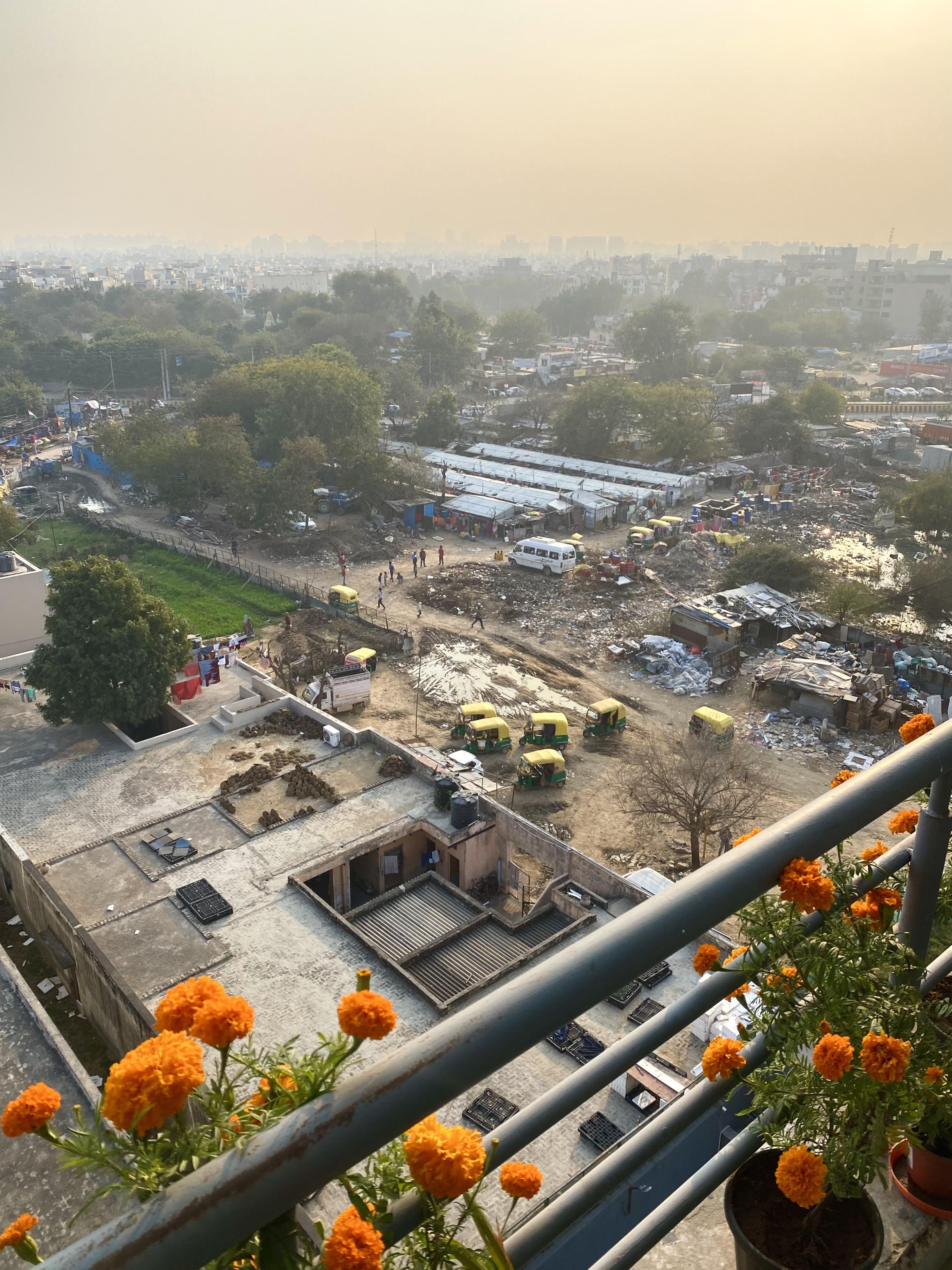This is the second article in a series. Read part one here. Read part three here.
It’s easy to see what’s motivating India’s emerging ecosystem of sustainable technology startups with a glance out the window from the office of Sangam Ventures in Gurugram, just outside of Delhi.
Several floors below the firm’s balcony, power lines crisscross over piles of garbage, a fleet of rickshaws, and cow patties on a rooftop that are being dried for use as cooking fuel. Above it all lies a blanket of yellowish smog.
“What we are trying to do as a fund is define what climate change entrepreneurship needs to look like,” Karthik Chandrasekar, the founder of early-stage cleantech venture capital firm Sangam, said in an interview at his office early last year.
“I don’t think you can just deploy solar and solve everything,” he said. “I think solar is a big component of it and a valuable part of it because of the scale and pricing it has reached. […] But I think you need large-scale, sustainable consumption-choice changes for all of this to work.”
Rapid growth in India’s renewable energy sector is driving demand for new technologies to modernize the country’s power sector. At the same time, there is a growing need to develop and deploy a broader suite of solutions aimed at reducing pollution.
In response, a vibrant ecosystem of sustainability-oriented startups, investors and incubators is taking shape in India today.
“I think we're just at the cusp of a real transformation of our startup ecosystem and seeing the cleantech startup ecosystem really blossom this year,” said Pratap Raju, founding partner of The Climate Collective Network, a nonprofit focused on building the ecosystem for climate entrepreneurship in South Asia.
Public concern about environmental issues has steadily increased over the past decade. This has moved these issues up the political priority list and bolstered a massive effort to diversify India’s economy away from coal and other polluting technologies and practices. The coronavirus pandemic dealt a blow to India’s economy, but the desire for a higher quality of life continues to move India’s startup ecosystem forward, according to Raju.
“Deals are continuing to close,” he said. “Investors are recognizing that there are short-term hiccups and disruption from COVID-19, but the growth prospects are strong.”
The network of cleantech startups that exists in India today only emerged in a meaningful way within the past few years. Experts say the sector was long held back because key stakeholders were operating in silos. Universities, incubators, investors and the public sector weren’t aligned on how to incentivize innovation, discover entrepreneurs and help researchers build a business. But that’s changing. India’s enormous talent pool is now being tapped to tackle some of the country’s greatest challenges.
Demand for flexible, clean power spurs startup activity
As the share of renewable energy on India’s electricity grid continues to rise and the smog continues to worsen, the need for flexible, clean power is increasing. That's attracting more entrepreneurs and investors to India’s cleantech sector. Renewable energy projects coupled with energy storage will “change the game” for India’s power grid, Raju said, by eliminating arguments that coal and gas are needed to provide baseload power.
“The actual number of self-described cleantech startups in India is quite low,” he said. “But when you look under the hood at the portfolio of startups and incubators and accelerators, there are large numbers of startups trying to solve our energy-efficiency problems [and accelerate] our transition to renewable energy.”
According to Raju, an estimated 20 percent of all startups in incubators in India are focused on some aspect of sustainability. Today, a growing number of them are focused on clean electricity.
“This is being driven, in particular, by the continuing success of India's renewable energy transition,” he said. “That is driving demand for new solutions to help stabilize the grid and to extend the power of renewables to the huge number of people who don't have access to electricity in any meaningful way.”
India has witnessed one of the fastest growth rates in renewables of all the major economies. When Raju joined the renewable energy sector in 2009, the amount of solar installed on the grid in India was roughly 3 megawatts. Today, it’s around 36,000 megawatts. Despite recent setbacks caused by the pandemic, the amount of both solar and wind on India’s grid is expected to grow exponentially over the next decade.
A study by The Energy and Resources Institute finds that power system flexibility will be the biggest challenge standing in the way of India’s goal to deploy 450 gigawatts of renewable energy by 2030.
Last year, the Indian government concluded two creative renewable energy tenders — one for peak power and the other for around-the-clock renewable power — to build the market for flexible renewables. The auctions represent a new era in India’s energy transition. Simply deploying wind and solar at scale is no longer sufficient. The rise of renewables is forcing utilities and other energy stakeholders to make the grid smarter, more resilient and efficient.

The view from Sangam Ventures. Photo credit: Julia Pyper
In 2020, Climate Collective partnered with the U.S.-based startup accelerator New Energy Nexus and the international nonprofit Regulatory Assistance Project to launch a startup program called ElectronVibe. Its goal is to develop new business models for India’s distribution utilities (discoms). Program applicants were asked to pitch ideas that would create additional revenue streams for the country’s severely indebted utilities or help improve grid resilience.
Submissions could include solutions on the customer side of the meter, including rooftop solar, demand response and battery energy storage. Participants were also encouraged to consider public-private and public-private-civil-society partnerships to ensure end-use efficiency in electricity consumption and higher levels of renewable energy penetration.
Winners of the first program round included Mumbai-based POWEReasy, which creates devices to monitor and manage electrical issues on the grid, and Bhopal-based Drmz System Innovations, which offers a low-cost wireless communication module as an alternative to existing smart meters. Other participants include startups working on microgrid solutions, electric vehicle fast-charging, and creating digital twins of the grid for better management. Winners receive assistance with developing their business models and the opportunity to undertake a pilot project with an interested discom.
ElectronVibe enables India’s struggling utility sector to crowdsource innovation while providing entrepreneurs with a way to engage with the power companies. This kind of creative partnership is a critical piece of the clean energy revolution taking place in India today, according to Kartikeya Singh, deputy program director at the SED Fund and senior associate with the India policy division at the Center for Strategic and International Studies.
“Indian utilities are the linchpin of India’s energy transition and helping India be a climate leader, but they need help in navigating the energy transition,” he said. “They are under tremendous political and economic pressure to operate with business models that are loss-making and don’t have the wherewithal to become the utilities of the future that India needs them to be.”
A maturing startup ecosystem to serve the world
Over the past few years, national and state governments in India have successfully expanded the power grid to villages in the countryside. But hundreds of millions of people in India still don’t have access to affordable and reliable power.
At the same time, while the skies over Delhi briefly cleared of smog this year amid coronavirus lockdowns, India remains home to 22 of the 30 most polluted cities in the world. Meanwhile, the pandemic has put 400 million Indians at risk of falling deeper into poverty, intensifying the need for affordable energy.
These factors are driving demand not only for reliable, clean grid power but also for electric vehicles, more efficient buildings and distributed energy solutions to serve remote areas.
In March, New Delhi-based clean energy investor cKers Finance raised $5 million from New Energy Nexus to boost the development of new distributed solar in India. The funds will be used to support both residential and commercial solar, as well as solar water pumps, floating solar and solar-powered refrigeration, marking another step forward for India’s cleantech startup ecosystem.
This week, cKers announced it had partnered with India’s OTO Capital in a first-of-its-kind initiative to finance two-wheeler electric vehicle purchases. Speaking of India’s broader cleantech ecosystem, Pawan Mehra, cKers director, said that successful products and services typically don't come from technology breakthroughs. Instead, they tend to be driven by entrepreneurs finding ways to package existing technologies to meet specific market needs.
“It's a deployment and business-model question,” he said in an interview. “It's not a technology question.”
India’s cleantech startup ecosystem is still in its early stages. But growing interest and investment in the space is not only positive for the nation’s own energy transition but also offers the potential of global impact. Communities in India share traits with communities across Southeast Asia and Africa, which means that solutions developed in one market could benefit another.
“India has the problems of sub-Saharan Africa and the brains of Silicon Valley,” said Shailesh Vikram Singh, an angel investor at the GoMassive Earth Network, a Noida-based incubator supporting the growth of early-stage climate tech startups, during an interview last year in Delhi. GoMassive launched in 2018 with $150 million in funding from Vijay Shekhar Sharma, founder of the popular Indian payment platform Paytm. The organization continues to mobilize angel investors to back clean energy entrepreneurship.
India has the ability to solve local pollution and climate-change challenges, while fostering economic development at the same time, Singh said.
“And if we can solve it, we won’t just solve it for India,” he said. “We will solve it for the whole Global South.”
***
Travel to India for portions of this story was supported by SED Fund, which supports a range of activities related to sustainability. All content is editorially independent, with no influence or input from the philanthropy. The views expressed in this article do not necessarily reflect the views of SED Fund or any of its affiliates.



